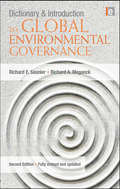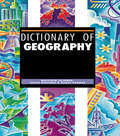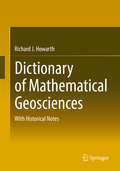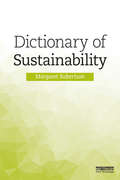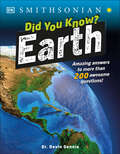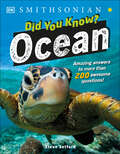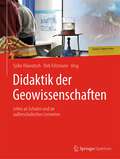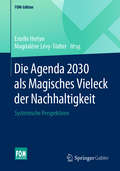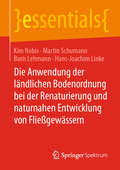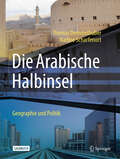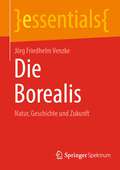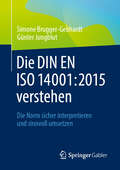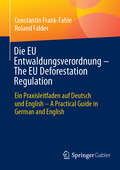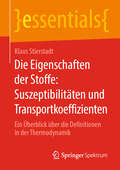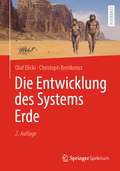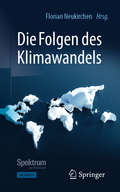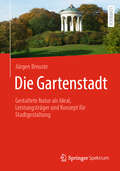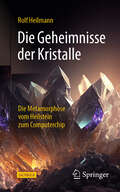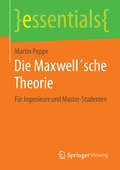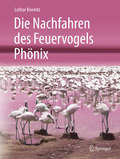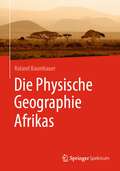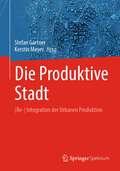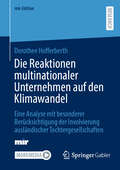- Table View
- List View
Dictionary and Introduction to Global Environmental Governance
by Richard A Meganck Richard E SaunierThis unique dictionary and introduction to Global Environmental Governance (GEG), written and compiled by two veterans of the international stage, provides a compilation of over 5500 terms, organizations and acronyms, drawn from hundreds of official sources. An introductory essay frames the major issues in GEG and outlines the pitfalls of talking past one another when discussing the most critical of issues facing the planet. It challenges those who are concerned with the management of our planet and its inhabitants to understand and accept a vocabulary common to the often-opposing objectives sought in the many GEG instruments. The result is a practical tool that should find a central place on the desk of anyone involved in environmental management, development or sustainability issues anywhere in the world, including the United Nations, government policy makers, NGOs and other stakeholder groups, the business community, and students and professionals. This fully revised and updated edition contains over 500 new entries and acronyms on global environmental governance as well a new introductory section on global water governance, one of the most pressing environmental issues in our era of climate change, growing populations and food shortages. Praise for the first edition:
Dictionary of Geography
by David Redfern Malcolm Skinner Geoff FarmerGeography as a subject covers a very wide range of topics, and the concepts are constantly being updated and revised. Dictionary if Geography , designed to aid understanding of a sometimes complex field, is an A-Z guide to key geographical terms. Each entry begins with a clear, one-sentence definition and is then developed in line with the relative importance of the concept covered, often through the use of worked examples and illustrations. Entries are carefully cross-referenced.
Dictionary of Mathematical Geosciences
by Richard J. HowarthThis dictionary includes a number of mathematical, statistical and computing terms and their definitions to assist geoscientists and provide guidance on the methods and terminology encountered in the literature. Each technical term used in the explanations can be found in the dictionary which also includes explanations of basics, such as trigonometric functions and logarithms. There are also citations from the relevant literature to show the term's first use in mathematics, statistics, etc. and its subsequent usage in geosciences.
Dictionary of Sustainability
by Margaret RobertsonThe Dictionary of Sustainability provides clear and accurate definitions of the extensive vocabulary that has developed in this emerging and interdisciplinary field, saving considerable time from searching through the massive quantity of information of differing degrees of quality that is available through the Internet. Providing authoritative definitions of standard terms used by scholars and practitioners it provides a clear and thorough conceptual framework and ensures those delving into topics for the first time, or returning to them, can quickly find what they need. It also contains careful use of cross-references, and includes several expanded entries to provide readers with nuanced understanding of important topics. The dictionary will be essential reading for all students studying sustainability topics, as well as a handy reference for practitioners wanting to make a sustainable difference in the workplace. ?
Did A Dinosaur Drink This Water?
by Robert E. WellsThe author explains the complete water cycle and also discusses ocean currents, ocean and lake habitats, and hydroelectricity. He also touches on water pollution and our responsibility to keep our water clean.
Did You Know? Earth: Amazing Answers to More than 200 Awesome Questions! (Why? Series)
by DKAn exciting children&’s encyclopedia that answers explosive geography questions about volcanoes, earthquakes, oceans, and more.Did you know that the Earth&’s largest waterfall is underwater, or that mountains grow? Our incredible planet is much more complex than young minds could ever imagine! Did you know? Earth is a thrilling encyclopedia for children aged 6-8 with a fascination for our planet and how it works. Packed with colorful illustrations, fun facts and quiz boxes, this encyclopedia helps children grasp the science behind our incredible planet. Did you know? Earth takes a unique approach, tackling important issues such as global warming and plastics in the ocean, alongside core geography topics, so children can learn all about how nature works and discover what we can do to look after planet Earth.This fascinating children&’s encyclopedia about the Earth:- Answers more than 200 questions, such as, &“Does land stay still?&” and &“How do raindrops make a cave?&” in an engaging question and answer format- Features stunning photographs and illustrations alongside fascinating facts - Structures each page around a question that a child might ask, providing young readers with a reassuring route into the subject- Includes &“Quick quiz&” boxes to test the reader on trivia- Has a fresh and simple design making each page easy to navigateHelp curious minds find out the answers to all the questions they may have, and some they haven't thought of yet! Can you freeze in a desert? Can humans make it rain? Is there life on moss? Covering amazing landforms, deep-sea wonders, and awesome weather, this encyclopedia helps early learners to understand the science behind our extraordinary planet.
Did You Know? Ocean (Why? Series)
by DKExplore the intriguing answers to more than 200 questions about oceans and seas in this absorbing encyclopedia of the natural world for kids. What is an ocean? How do waves form? What lives at the bottom of the sea? This children's ebook helps inquisitive minds find out the answers to all the questions they may have about seas and oceans, and some they hadn't thought of! Featuring amazing sea creatures, geological wonders, and marine exploration, How Deep is the Ocean? lets children dip their toes into oceanography and explore its incredible depths. Each page asks and answers a different question, and features a quick quiz designed to cement new knowledge. Bursting with mind-boggling details and fascinating facts, this visually stunning book will be treasured by every young ocean enthusiast.
Did a Dinosaur Drink This Water?
by Robert E WellsIt's hard to imagine--the molecules in the glass of water you just finished might have once been part of a water hole that dinosaurs drank from! In this fascinating new book about the water cycle, readers will find that while it might be hard to imagine, it's true. The author, Robert E. Wells, explains the complete water cycle and also discusses ocean currents, ocean and lake habitats, and hydroelectricity. He also touches on water pollution and our responsibility to keep our water clean. The author's bright cartoon illustrations make this information especially appealing to kids.
Didaktik der Geowissenschaften: Lehre an Schulen und an außerschulischen Lernorten
by Sylke Hlawatsch Dirk FelzmannDie Menschheit steht heute vor der Herausforderung, globale Umweltveränderungen so zu beeinflussen, dass der Planet Erde langfristig als ihr Lebensraum erhalten bleibt. Wichtiges Wissen dafür liefern die Geowissenschaften, die heute interdisziplinär und auf naturwissenschaftliche Weise die Prozesse im System Erde erforschen. Ein Verständnis ihrer zentralen Ergebnisse und ihrer Denk- und Arbeitsweisen ist damit eine wichtige Voraussetzung, an der Gestaltung einer nachhaltigen Entwicklung teilhaben zu können. Mit diesem Sammelband liegt eine erste deutschsprachige Didaktik der Geowissenschaften vor, die anhand der international etablierten interdisziplinären Earth Systems Education Formate geowissenschaftlicher Vermittlung konkretisiert.Im disziplinär organisierten deutschen Schulsystem bietet geowissenschaftlicher Unterricht innovativen Kompetenzerwerb im interdisziplinären Kontext System Erde und fördert das Verständnis grundlegender Fragen zur Erdgeschichte und zum Verhältnis zwischen Mensch und Natur. Zahlreiche Praxisbeispiele veranschaulichen die naturwissenschaftliche Betrachtung der Erde als Gesamtsystem im Schulunterricht. Geowissenschaftlerinnen und Geowissenschaftler mit Interesse an der Vermittlung ihrer Inhalte lernen grundlegende pädagogische und didaktische Prinzipien und Methoden kennen. Sie erfahren, wie sie Schülerinnen und Schülern Lernerfahrungen ermöglichen, die das schulische Lernen passgenau ergänzen, und wie sie Lehrkräfte in deren geowissenschaftlichen Unterricht unterstützen.Das Werk richtet sich an Lehramtsstudierende und Lehrkräfte der Geowissenschaften, Geographie, Biologie, Chemie und Physik genauso wie an alle, die Geowissenschaften außerschulisch vermitteln (z. B. Museen, Geoparks, Öffentlichkeitsarbeit).
Die Agenda 2030 als Magisches Vieleck der Nachhaltigkeit: Systemische Perspektiven (FOM-Edition)
by Magdalène Lévy-Tödter Estelle HerlynEin Buch zur größten Herausforderung unserer Zeit – der Umsetzung der Agenda 2030 Dieses Buch setzt sich mit der Agenda 2030 und den 17 Sustainable Development Goals auseinander, die – in noch komplexerer Weise als das „Magische Viereck“ der Wirtschaftspolitik – ein Zielsystem mit zahlreichen Wechselwirkungen und Zielkonflikten aufspannen. Das Ziel der Agenda ist es, die Welt in einen Zustand zu bringen, in dem die planetaren Grenzen dauerhaft eingehalten und die Bedürfnisse aller Menschen befriedigt werden. Dabei kann der Zustand des Gesamtsystems anhand von fünf Systemparametern beschrieben werden: Weltbevölkerungsgröße, BIP, Verteilung des Wohlstands, benötigte Ressourcen relativ zur Ressourcenverfügbarkeit und technologischer Fortschritt.Die globale Reichweite der Agenda und verteilte Verantwortungen – von global bis national, über klassische Politikressorts hinweg und nicht zuletzt über verschiedene Akteursgruppen wie z. B. neben der Politik die Unternehmen und die Zivilgesellschaft – erzeugen eine große Komplexität. Das anhaltende Weltbevölkerungswachstum und ungeklärte Finanzierungsfragen stellen weitere große Herausforderungen dar, welche dem Leser erläutert und schließlich anhand einzelner Handlungsfelder und möglicher Lösungsansätze zur Förderung von Entwicklung und internationalem Umwelt- und Klimaschutz konkretisiert werden. Der InhaltLösungsansätze der NachhaltigkeitEinführung in das Magische VieleckUnternehmerische Gemeinschaften und nachhaltige EntwicklungDer Marshall Plan mit Afrika als Ansatz zur Umsetzung der Agenda 2030Anforderungen an nachhaltige Emissionshandelssysteme im Spannungsfeld der Agenda 2030Nachhaltige AgrarwirtschaftAbfall- und Kreislaufwirtschaft im Spannungsfeld der Agenda 2030Nachhaltiger Tourismus in EntwicklungsländernEinblicke in die Analyse der globalen ÄrztemobilitätNachhaltigkeitsziele der Agenda 2030 aus chinesischer PerspektiveNachhaltiger Konsum, Handel und Produktion
Die Anwendung der ländlichen Bodenordnung bei der Renaturierung und naturnahen Entwicklung von Fließgewässern (essentials)
by Boris Lehmann Martin Schumann Kim Nobis Hans-Joachim LinkeDie ländliche Bodenordnung stellt ein wichtiges Instrument zur Bereitstellung und Sicherung der Fläche dar, die für die naturnahe Entwicklung anthropogen veränderter Fließgewässer hin zu eigendynamisch resistenten und resilienten Systemen benötigt wird. In diesem essential geben die Autoren einen Überblick über die Renaturierung und naturnahe Entwicklung von Fließgewässern und die grundlegenden Aspekte der ländlichen Bodenordnung. Die Analyse eines Praxisbeispiels aus Hessen verdeutlicht die Verknüpfung beider Bereiche und ermöglicht so die Entwicklung von Handlungsempfehlungen.
Die Arabische Halbinsel: Geographie und Politik
by Thomas Demmelhuber Nadine ScharfenortDieses Buch bietet eine umfassende interdisziplinäre Einführung in die geographischen und politischen Besonderheiten der Arabischen Halbinsel im Kontext aktueller Megatrends wie Klimakrise, Migration und geopolitische Verwerfungen. Die Arabische Halbinsel ist ein Knotenpunkt der Debatte und selbst ein wesentlicher Akteur. Es beleuchtet die Rolle der Region im Übergang in ein Post-Öl-Zeitalter und analysiert infrastrukturelle Großprojekte, sportliche Großveranstaltungen sowie visionäre Entwicklungspläne. Dabei berücksichtigt es die historischen Entwicklungslinien, ordnet Umbrüche ein und beleuchtet Themen wie dynastische Herrschaftsstrukturen, Anpassungsstrategien in Zeiten der Energiewende, Klimapolitik, Digitalisierung, die Konstruktion von Identitäten, Migration, Arbeitsmarktfragen und die Diversifizierung der Wirtschaft. Dabei wird die Region nicht als homogene Einheit betrachtet, sondern in die zahlreichen ökonomischen, politischen und kulturellen Verflechtungen mit der weiteren MENA-Region sowie globalen Weltregionen eingebettet. Das erste deutschsprachige Buch dieser Art vereint die vielstimmige und hochkompetente Forschung der deutschsprachigen Wissenschaft zur Arabischen Halbinsel. Es richtet sich an Forscher, Wissenschaftler und Fachleute aus den Bereichen Geographie, Politikwissenschaften und Nahoststudien sowie an allgemein an der Region interessierten Laien. Es bietet wertvolle Einblicke in die komplexen Verflechtungen der Region mit dem Nahen Osten, Nordafrika und darüber hinaus. Leser*innen werden durch dieses Werk ein tiefgehendes Verständnis für die dynamischen Entwicklungen auf der Arabischen Halbinsel gewinnen und ihre Expertise in transregionalen Studien erweitern.
Die Borealis: Natur, Geschichte und Zukunft (essentials)
by Jörg Friedhelm VenzkeDie Borealis – die größte Waldzone der Erde – ist höchst bedeutsam für das Weltklima, birgt enorme Rohstoff- und Energieressourcen, ist äußerst dünn besiedelt, wird allerdings in der Öffentlichkeit nur relativ wenig wahrgenommen.Dieses essential skizziert ihre ökologischen Strukturen und die Geschichte ihrer Entschließung, zeigt verschiedene Problemfelder zwischen Inwertsetzung und Schutz sowie des Lebens in kaltem Milieu auf und versucht der Frage nachzugehen, wie die Zukunft dieses riesigen nördlichen Naturraumes und seine Bedeutung für den ganzen Planeten aussehen kann.
Die DIN EN ISO 14001: Die Norm sicher interpretieren und sinnvoll umsetzen
by Simone Brugger-Gebhardt Günter JungblutDas Buch führt in einfacher und verständlicher Sprache in die wichtigsten Grundprinzipien und Zielsetzungen der Umweltmanagementsystem-Norm DIN EN ISO 14001:2015 ein und erleichtert damit die Umsetzung in die Unternehmenspraxis. Jedes einzelne Kapitel der Norm wird ausführlich erklärt und anhand von zahlreichen Tipps und Praxisbeispielen näher verdeutlicht. Geklärt werden auch die zehn wichtigsten Normirrtümer, die häufig zu mehr Bürokratie führen. Das Verständnis für das eigene Umweltmanagementsystem und die sichere Argumentation in Zertifizierungsaudits wird durch das Buch ermöglicht. Außerdem wird auf Möglichkeiten eingegangen, ein Umweltmanagementsystem mit anderen Managementsystemen zu kombinieren und so ein effizientes integriertes Managementsystem zu erreichen.
Die EU Entwaldungsverordnung – The EU Deforestation Regulation: Ein Praxisleitfaden auf Deutsch und English – A Practical Guide in German and English
by Roland Falder Constantin Frank-FahleDie EU-Entwaldungsverordnung (EUDR) vom 31. Mai 2023, Teil des European Green Deal von 2019, soll weltweite Entwaldung und Waldschädigung bekämpfen. Dieser zweisprachige Leitfaden schließt Informationslücken, unterstützt Unternehmen bei der Umsetzung der Verordnung und behandelt Kritik sowie offene Fragen. The EU Deforestation Regulation (EUDR) of 31 May 2023, part of the 2019 European Green Deal, aims to combat global deforestation and forest degradation. This bilingual guide addresses information gaps, supports companies in implementing the regulation, and tackles criticism and unresolved issues.
Die Eigenschaften der Stoffe: Ein Überblick über die Definitionen in der Thermodynamik (essentials)
by Klaus StierstadtDieses essential gibt einen Überblick über die Definitionen von Suszeptibilitäten bzw. Responsefunktionen und von Transportkoeffizienten in Materie. Es zeigt, wie Suszeptibilitäten aus thermodynamischen Potenzialen berechnet werden können und wie man Transportkoeffizienten auf die Eigenschaften der Atome zurückführt. Das essential ist Teil einer dreiteiligen Reihe zur Thermodynamik, zusammen mit Temperatur und Wärme – was ist das wirklich? und Thermodynamische Potenziale und Zustandssumme.
Die Entwicklung des Systems Erde
by Olaf Elicki Christoph BreitkreuzDen Ansatz der klassischen Historischen Geologie aufgreifend, fokussieren die Autoren in diesem neukonzipierten Lehrbuch auf die biogenen und nicht-biogenen Prozesse der Erdentwicklung. Seit der Entstehung unseres Planeten vor etwa 4,5 Milliarden Jahren finden diese komplexen und sich in vielerlei Hinsicht gegenseitig beeinflussenden Prozesse auf zahlreichen Ebenen statt. Alle Sphären unseres Planeten interagieren miteinander und erzeugen ein permanentes Feedback. Einige dieser Prozesse sind unumkehrbar, wie das Wachstum der Kontinente oder die biologische Evolution, andere Phänomene dagegen laufen zyklisch ab, wie etwa Variationen des Klimas und der Meeresspiegelhöhe. Es gibt Vorgänge, die uns vertraut sind, da sie immer wieder in der Erdgeschichte auftreten oder weil wir sie auch heute als aktive Prozesse beobachten können; andere hingegen sind selten oder gar einmalig und die Erklärung ihrer Phänomene und Ursachen verlangt fachübergreifendes Wissen ebenso wie eine frische und unvoreingenommene Herangehensweise. Die Autoren führen erdwissenschaftliche und biowissenschaftliche Sichtweisen zusammen, da sich so die eng verwobene Koevolution von Planet und Leben in der geologischen Vergangenheit und der Gegenwart verstehen lässt. Sie dokumentieren die wesentlichen Prozesse der Erdentwicklung. Der „rote Faden“ des Buches ist die Zeit. Frühe Zeitabschnitte, wie das Hadaikum und das Archaikum, oder die kambrische Faunenexplosion finden ebenso besondere Beachtung wie die jüngsten Entwicklungen im Quartär. Die wichtigsten Methoden und Werkzeuge werden erläutert. Ein spezieller Schwerpunkt des Buches ist die Biosphäre – ihre Entstehung, Entwicklung und die Auswirkungen der biologischen Evolution auf Atmo-, Hydro- und Geosphäre.In der vorliegender Neuauflage wurden alle Kapitel dem jüngsten wissenschaftlichen Kenntnisfortschritt angepasst und um zahlreiche Abbildungen erweitert. Insbesondere wurden die Themen zur Entstehung und frühen Evolution des Lebens, zu den Prozessen und Vorkommen im jüngeren Känozoikum Mitteleuropas sowie zur Entstehung und Entwicklung des Menschen und auch die aktuelle Problematik des Anthropozäns deutlich ausgeweitet bzw. neu hinzugefügt. Das Lehrbuch ist für Studierende der Geowissenschaften ab dem 2. Studienjahr konzipiert, soll aber auch Studierenden benachbarter Disziplinen als Einstieg in das „System Erde“ und als Nachschlagewerk dienen. Auch für Wissenschaftler und professionelle Nutzer der angewandten Geowissenschaften und Geotechnik wird es hilfreich sein. Zugleich spricht es Lehrer der geo- und bio-relevanten Fächer sowie interessierte Laien an.
Die Folgen des Klimawandels
by Florian NeukirchenDer Klimawandel ist in aller Munde und kaum jemand stellt infrage, dass Maßnahmen für den Klimaschutz ergriffen werden müssen. Doch wie würde sich eine Klimaerwärmung um 1,5 oder 2 °C nun wirklich auswirken? Wie viele Treibhausgase können noch ausgestoßen werden, ohne diese Grenzen zu überschreiten? Wie ändert sich der Einfluss von Wolken, Wäldern und Böden auf den Treibhauseffekt? Wie reagieren Ökosysteme auf die Veränderungen? Und welche sind am stärksten betroffen? Hängen heutige Extremwetterlagen mit dem Klimawandel zusammen? Solche Fragen sind nicht leicht zu beantworten. Die in diesem Buch gesammelten Artikel geben tiefe Einblicke in die aktuelle Forschung. Sie lassen uns an Expeditionen in die Arktis und die Antarktis ebenso teilhaben wie an Tauchgängen an Korallenriffen. Die Ergebnisse langer Messreihen und verbesserter Computermodelle werden vorgestellt und offene Fragen genannt. Auf anschauliche Weise werden so wichtige Zusammenhänge aufgezeigt und beispielsweise das Verhalten sogenannter Kippelemente erklärt. Nebenbei erfahren wir einiges über die Geschichte der Klimaforschung und können so nachvollziehen, wie sehr sich unsere Sicht auf das Klima verändert hat.
Die Gartenstadt: Gestaltete Natur als Ideal, Leistungsträger und Konzept für Stadtgestaltung
by Jürgen BreusteDieses Lehrbuch untersucht Stadtgärten, ihre Erscheinungsformen, ihren Nutzen und ihre Nutzer*innen, ihre Entwicklungschancen und Herausforderung und stellt dabei Gärten als idealisierte Stadtoasen, Ökosysteme und Teil von Stadtentwicklungskonzepten in den Mittelpunkt. Es beantwortet wichtige aktuelle Fragen zu den ökologischen und sozio-kulturellen Grundlagen von Stadtgärten, zu ihrer Struktur, zum ökologischen Leistungsvermögen, zum Gartenmanagement und zur Gartennutzung und zur Perspektive von Stadtgärten. Das Buch erklärt, was Stadtgärten sind, warum sie Teil von Städten sind, was die Bewohner der Städte aus ihnen machen können und wie ganze Stadtentwicklungskonzepte auf ihnen aufbauen. Es geht davon aus, dass urbanes Leben Stadtgärten und ihre Leistungseigenschaften als gemeinschaftliche und individuelle Erholungsräume, Klimamoderatoren und Lebensräume für Pflanzen und Tiere braucht. Neue Gärten und Urban Gardening bringen neue Trends zum Ausdruck. Städtisches Lebenist ohne Gärten nicht erstrebenswert, denn ohne gestaltete Natur in unserer Lebensumwelt verlieren wir weiter den Naturkontakt. Theorien und Erkenntnisse der Stadtentwicklung, Ökologie und Urbanistik werden mit praktischen Anwendungen in der Stadtplanung verbunden und mit vielen Fallstudien und weltweiten Beispielen veranschaulicht. Die großen Potenziale von Stadtgärten werden im Detail aufgezeigt. Im Gartenstadt-Konzept zum Ideal des städtischen Lebens im Grünen erhoben, ist Leben im Haus allein oder mit anderen mit Garten in der Stadt immer noch erstrebenswert.Das Lehrbuch spricht besonders Studierende und Lehrende der Fächer Stadt- und Raumplanung, Ökologie, Biologie, Landschaftsarchitektur, Landschaftspflege, Geographie, Urbanistik, Sozialwissenschaften sowie Praktiker der Stadtgestaltung und -entwicklung an.
Die Geheimnisse der Kristalle: Die Metamorphose vom Heilstein zum Computerchip
by Rolf HeilmannKristalle – von den Wurzeln der Heilkunst zur Spitze der Technologie Kristalle, jahrtausendelang verehrt für ihre Perfektion in Form und Farbe, erzählen eine Geschichte, die tief in der Vergangenheit beginnt und bis in die Gegenwart reicht. Im vorliegenden Sachbuch enthüllt Prof. Dr. Rolf Heilmann die bemerkenswerte Evolution der Bedeutung dieser faszinierenden Mineralien. Das Werk bietet eine gründliche Analyse darüber, wie Kristalle – einst geheimnisvolle Symbole der Macht – zu unverzichtbaren Bausteinen moderner Technologien avancierten. Von der Erforschung der Grundstrukturen unserer Welt bis zur Fertigung von Solarzellen und Siliziumchips in Computern eröffnet Heilmann einen Zugang zur Welt der Kristalle, der sowohl Laien als auch Fachleute anspricht.
Die Maxwell´sche Theorie: Für Ingenieure und Master-Studenten (essentials)
by Martin PoppeMartin Poppe stellt die Maxwell'schen Gleichungen vor und interpretiert sie vor dem Hintergrund wichtiger Ergebnisse der Grundlagenforschung. Seine zentralen Anliegen sind Verständlichkeit und Anwendbarkeit. Daher verzichtet der Autor auf die im neunzehnten Jahrhundert eingeführten und mittlerweile als redundant erkannten Hilfsgrößen. So wird die Theorie einfacher, übersichtlicher, leichter zu nutzen und von weit verbreiteten Missverständnissen befreit.
Die Nachfahren des Feuervogels Phönix
by Lothar KrienitzDer Leser erhält in diesem Buch einzigartige Einblicke in den faszinierenden Lebensraum und das Leben der Zwergflamingos. Flamingos gelten als Verkörperung des Feuervogels Phönix. Der Autor hat ihre Einstandsgebiete in Afrika und Indien untersucht. Die Umwelt des Zwergflamingos ist durch Hitze, Vulkanasche und Salz geprägt. Er ist an die extremen Bedingungen tropischer Sodaseen angepasst und widersteht selbst der ätzenden Wirkung von Salzlauge. Doch der Mensch greift immer stärker in die Kreisläufe dieser Feuchtgebiete ein. Für den pinkfarbenen Charaktervogel der Salzseen, wird es schwieriger, Lebensraum, Nahrung und Brutplätze zu finden. Sein Schicksal gilt als warnendes Beispiel für den Umgang des Menschen mit der Natur. Wird es den Ebenbildern des Phönix gelingen, in einer vom Menschen geprägten Welt zu überleben? Beobachtungen und Erlebnisse in den ungewöhnlichen Lebensräumen werden vom Autor mit dem Phönixmotiv verwoben und sollen zum Nachdenken über die Kreisläufe des Lebens anregen.
Die Physische Geographie Afrikas
by Roland BaumhauerDas vorliegende Buch ist eine lang überfällige, aktuelle geographisch-geowissenschaftliche Gesamtdarstellung der wesentlichen Geo- und Umweltfaktoren des afrikanischen Kontinents. Im Mittelpunkt stehen Gestein, Relief, Klima, Wasser, Boden, und Vegetation. Diese steuern die landschaftsprägenden Prozesse an der Erdoberfläche und bestimmen Struktur, Funktion und Dynamik des Naturraumes – der natürlichen Umwelt und der vom Menschen durch Landnutzung, Siedlungen, Verkehrswege u.s.w. gestalteten Umwelt. Ergänzende Exkurse vertiefen eine Reihe von wichtigen aktuellen Umweltfragen im Zusammenhang mit der menschlichen Nutzung (z. B. Bodenerosion, Desertifikation), dem Klimawandel oder erläutern geowissenschaftliche Fachbegriffe. Reiche Farbfotographien und spannende Kartographie veranschaulichen die Informationen und sorgen für ein besseres Verständnis. Dem interessierten Leser soll mit dem Buch einerseits ein schneller Überblick über die Physische Geographie des Kontinents gegeben werden. Andererseits kann das Buch als geordnetes Nachschlagewerk genutzt werden. Es wendet sich nicht nur an Studierende der einschlägigen Studiengänge, sondern auch an einen breiten, an allen Umweltaspekten Afrikas interessierten Leserkreis bis hin zu Mitarbeitern von Entwicklungsorganisationen und Fachkräften im Entwicklungsdienst, die grundlegende Informationen zur Physischen Geographie des Kontinents brauchen.
Die Produktive Stadt: (Re-) Integration der Urbanen Produktion
by Kerstin Meyer Stefan GärtnerDieser Sammelband stellt die Urbane Produktion als wesentlichen Bestandteil der Produktiven Stadt vor. Er gibt einen Überblick zu Ideengeschichten, aktuellen Diskussionen, Konzepten, Definitionen, Messbarkeit, Relevanz und Potenzialen von Produktionsprozessen im urbanen Raum. Dabei werden notwendige Rahmenbedingungen und deren Wirkungen zum Erhalt und zur Förderung Urbaner Produktion betrachtet.Der Mehrwert des Bandes liegt unter anderem darin, dass auf der einen Seite Herausforderungen und Lösungsmöglichkeiten aus verschiedenen Perspektiven vorgestellt werden, diese aber auf der anderen Seite nach verschiedenen räumlichen Planungsebenen bis hin zur Objekt- bzw. Immobilien-Ebene differenziert werden. Um die Produktive Stadt zu sichern und zu erweitern, bedarf es inter- und transdisziplinärer Bemühungen.Somit diskutieren WissenschaftlerInnen aus unterschiedlichen Disziplinen (Architektur, Maschinenbau, Stadt- und Raumplanung, Stadt- und Immobilienökonomie, Planungsrecht) die Herausforderungen und Potenziale und unterlegen sie mit Beispielen von gelungenen (Re-) Integrationen der Produktion in die Stadt.Das Buch richtet sich sowohl an Studierende, WissenschaftlerInnen als auch StadtplanerInnen und PraktikerInnen aus Architektur, Immobilien-, Stadt- und Unternehmensentwicklung, Planungs- und Bauordnungsrecht sowie Wirtschaftsförderung.
Die Reaktionen multinationaler Unternehmen auf den Klimawandel: Eine Analyse mit besonderer Berücksichtigung der Involvierung ausländischer Tochtergesellschaften (mir-Edition)
by Dorothee HofferberthDie besondere Relevanz multinationaler Unternehmen im Kontext des Klimawandels ergibt sich aus deren globaler Wirkung ohne Beschränkung auf einzelne Länder. Neben dem Umgang mit heterogen physischen Auswirkungen müssen ebenso unterschiedliche rechtliche Vorgaben, gesellschaftliche Dynamiken und der Druck multipler Stakeholder beachtet werden. Die Bewältigung der komplexen Einflüsse stellt somit eine erhebliche Herausforderung für multinationale Unternehmen dar. Vor dem Hintergrund dieser Entwicklung konzentriert sich die vorliegende Forschung auf den Beitrag multinationaler Unternehmen zum Klimaschutz. Sie spielen als maßgebliche Akteure in den globalen Klimaschutzbemühungen eine bedeutende Rolle, da sie sowohl zu den Verursachern von Emissionen gehören, als auch auf Grund ihrer global verstreuten ausländischen Tochtergesellschaften den vielfältigen physischen Auswirkungen des Klimawandels ausgesetzt sind. Diese Diskrepanz zwischen Verantwortung und Auswirkung ist die treibende Motivation für das Forschungsinteresse. Ziel dieser Arbeit ist es, die Reaktionen multinationaler Unternehmen auf den Klimawandel mit besonderer Berücksichtigung der Involvierung ihrer ausländischen Tochtergesellschaften zu untersuchen, um ein tieferes Verständnis für ihr Handeln im Kontext des Klimawandels zu gewinnen.
